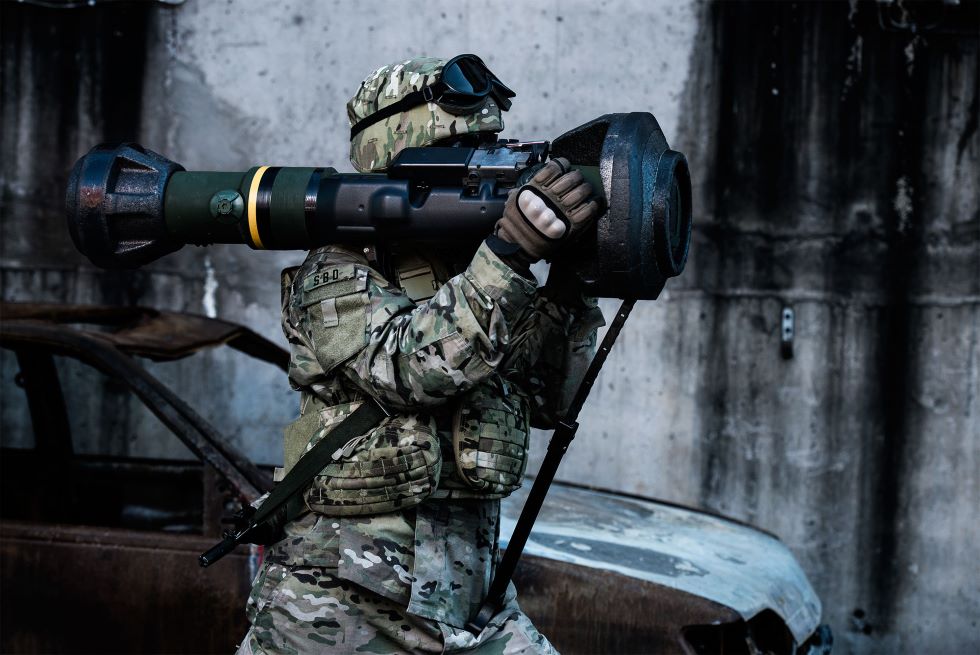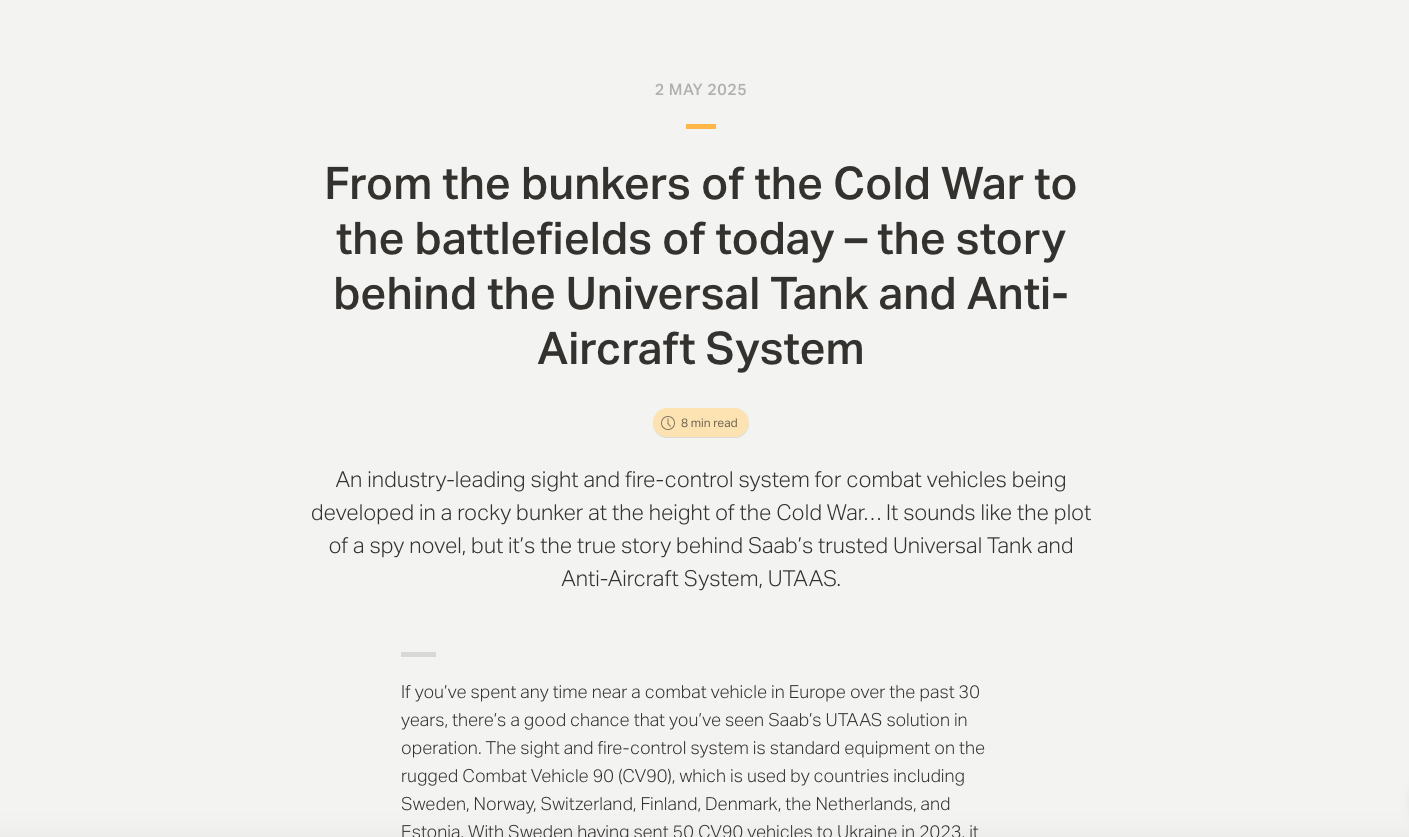Project Description

Game changer against tanks
CLIENT: Appelberg Publishing Stockholm
PUBLISHED: Saab Group website/Facebook
ORIGINAL ARTICLE: 5 facts about NLAW
CREATED: June 2018
AUTHOR: Fallon Dasey
STORY
11 June 2018
The global political situation is in flux. After many years of stability, European nations are concerned about a threat from the east and looking to substantially increase their defences at home.
At the same time, main battle tanks have become an even more dominant force in armed conflicts. Armed with more sophisticated weapons and counter measures, they are now an invaluable tool in complex terrain, helping advancing forces to destroy entire buildings to root out the enemy.
What’s needed is a weapon capable of taking away the tactical advantage of MBTs and restoring the balance of power to defending forces. Here, Lars-Örjan Hovbrandt, Technical Sales Support Manager for Ground Combat within Saab Dynamics, gives five reasons why Saab’s New generation Light Anti-tank Weapon (NLAW) is that weapon
1. NLAW stops tanks dead in their tracks.
Weighing just 12.5 kilograms, NLAW is a portable, shoulder-launched system that can be used by a single operator. Its armour-piercing warhead can destroy a heavily protected modern battle tank with one shot, and the system is effective at ranges between 20 and 800 metres.
Lars-Örjan Hovbrandt says in the field, this combination of mobility, flexibility and destructiveness is a game-changer. “With NLAW, you don’t need a platoon to attack tanks,” he says. “You can train an ordinary soldier to use the system in an hour. And then you can have NLAW-equipped soldiers across the entire environment waiting for a tank to advance. There could be an NLAW equipped solder behind any rock or bush.”
Hovbrandt says where tank operators and advancing forces could once track down anti-tank platoons to neutralise the opposition, they now face a threat that is far harder to locate – and more lethal. NLAW forces tanks to change course so they can be herded them into ambushes.
2. NLAW hits the target.
One of the major challenges anti-tank weapons face in complex environments is hitting the target despite countermeasures and obstacles including other vehicles, heat sources and power lines. Unlike many other anti-tank weapons, NLAW does not rely on active target seeking system. Instead, it uses ‘predicted line of sight’ targeting, incorporating magnetic and optical sensors to rapidly travel to the target location. No lock on signature is required. The operator simply tracks the target for a few seconds before firing and NLAW does the rest.
Lars-Örjan Hovbrandt says NLAW also allows operators to quickly select the distance at which the missile arms itself. “Say you are in complex terrain where a number of vehicles have been hit and you have a burning vehicle 50 metres in front of you and the true target is 150 metres away. You just switch over the arm distance to 100 metres. The missile will fly blind over the first target and then start looking for the target.”
3. NLAW leaves tanks nowhere to hide.
While many anti-tank missiles need to first gain altitude before launching a top attack, NLAW’s Overfly Attack function is effective at a range of just 20 metres making it effective at short range and even in situations where a tank in under cover. The missile flies about a metre over the top of the tank and launches devastating attack on the roof. The system is also extremely effective in situations where the operator can only see a tiny portion of the tank. “If a tank is concealed behind cover with a hatch or antenna visible, the NLAW operator simply aims at the visible part of the tank,” says Lars-Örjan Hovbrandt. “The missile then travels one metre above the line of sight before taking the tank out from above.”
4. NLAW turns the hunter into the hunted.
Tanks have traditionally allowed operators to hunt down the opposition in relative safety. NLAW turns the tables. Because it is man portable and flexible, it allows tanks to be attacked from almost any position – from high up in a building, from behind a tree or from within a ditch. It can also be fired safely from within enclosed spaces, such as rooms, even with other soldiers present. “You can be anywhere,” says Lars-Örjan Hovbrandt says. “You can fire down 45 degrees and can shoot from inside a building, from a basement or from the second floor of a building out of the range of most tanks.” The system is equally effective day or night.
5. NLAW can destroy different targets.
While NLAW has the power to stop a tank, it is also effective against a range of other targets. In direct attack mode, it can be used against soft targets like trucks, buses cars, helicopters. When fired directly through a window and into a building fragments will cause significant damage.
Another key benefit is its fast response time. “For a trained gunner, it takes just five or six seconds to go from carrying it in his left hand, to raise it to his shoulder, get out the sites, select firing support, and aim at the target,” says Lars-Örjan Hovbrandt. “The missile can cover 400 metres in under two seconds. So, it can be up to 600 metres away in less than 10 seconds. That’s very fast.”



